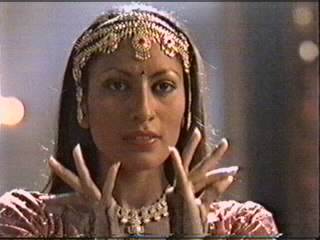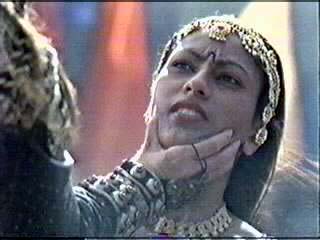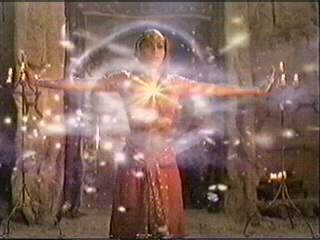



BEHIND THE LINES
Interview by: SLK
slk@ausxip.com
What’s a Sydney law student doing teaching Beginner Bodypainting
For Bards and facing down evil shamanesses? Well why the heck not?
SLK reports exclusively for XIP.
T
he first time the tiny Tharini Mudaliar, standing all of 5ft 3inches (minus the apple crate) as Naiyima, realised she was going to have to square off against the six-foot tall, cloud-scraping Claire Stansfield (the dastardly Alti), she knew it was going be one awfully short fight. It didn’t matter one hoot what the script called for in the closing fight of Between The Lines because Tharini (pronounced Ta-ree-nee) knew the real deal. And it sure wasn’t gonna be pretty... "When we came together they were almost
going to stand me on an apple crate because I was so much smaller than Claire was,"
Tharini recalls with a chuckle. "They didn't actually have to in that fight scene
with Claire in the end, because they shot it upwards from my point of view.
"When we came together they were almost
going to stand me on an apple crate because I was so much smaller than Claire was,"
Tharini recalls with a chuckle. "They didn't actually have to in that fight scene
with Claire in the end, because they shot it upwards from my point of view.
"I’m pretty small. If you’d ask me, I’d say she (Claire) was even taller than six foot. Rick (Jacobson) the director said ‘Okay, I want you (Claire) to put your hand under Tharini’s throat’.
"And they had the wind machine going. The wind machine is like a whole wall of a room that is a big fan and they get it going to create this wind. And I was falling over in the wind. I couldn’t stand up. It was like ‘ha-annggg onto a treeeeee....’ The wind was just blowing me over.
"And there was Claire with her hand under my chin and I was like "Nup, she’s gonna win. Nup. Can’t do it - how am I supposed to beat her?! She’s HUGE," Tharini jokes.
Fortunately for Tharini, the windblown Naiyima somehow snatched victory from the jaws of defeat and lived to tell, er, pulsate, whatever, for another day. Although, her glowing finale was a little different to how they filmed it.
Tharini reveals a little editing snip to her grand exit that fans wouldn’t have seen:
"Before Naiyima goes up in her ball of light, there was a shot of the villagers on their knees and the executioner guy’s like: ‘We didn’t know, we didn’t know you were the Enlightened One; forgive us’."
"And she sort of benevolently smiles at them and goes up into the ether.
"I don’t know what happened (for that to be cut). It just goes to show the whole show is really about Xena and Gabrielle and the characters come in to complement them, but you really don’t need closure about the (other) characters...whatever happens, happens."
Xena guest spot roles are not exactly your typical side job for Sydney University students, where Tharini spends her days in her final few years of a law degree. But it’s a nifty sideline for her; wherever it takes her.
The 22-year-old South African-born Indian, who moved to Tasmania when she was only one, and then to Adelaide, South Australia, a few years later, sounds like your average bubbly, fun Aussie - her voice actually not dissimilar from that of her cousin’s, SBS newsreader Indira Naidoo. Nonetheless Tharini had to bung on a fake "flavour of India but not Indian" accent as per the director’s orders for the job.
Weird as that accent request sounds, undefined accents seem to have become Tharini’s forte: Her first major acting role was at age 19, in a nine-month stint in the last season of the acclaimed Australian children’s TV series Ocean Girl. She played the smoothly evil Shesheba, an Egyptianesque bad gal with the intriguing but, again, never defined accent to match.
Fortunately, Tharini had the exotic look to go with her flexible voice and it proved to be just what the Xena casting department was looking for. But there was another thing they wanted for their Naiyima, too:
"(My agent) said: ‘Look, they liked your audition and they wanted to know if you can dance’. And I’m not a dancer, I’ve never had any dance training," Tharini recalls. "So she said, ‘She’s not a dancer but she can move’.
"So they sent back saying, ‘Would you be happy to work with a choreographer for a week and just learn some classical Indian dancing?’ And I said ‘Yep, yep I would’.
"And I had done maybe a year of classical Indian dancing when I was about five in Adelaide. We said, ‘Yeah yeah, she’s had a year of classical Indian dancing. We didn’t say it was when I was five!’ "
After she got the role, she found herself in New Zealand, and in a different world entirely.
"I went over there and the producers welcome the actors and make an effort to introduce them to all the people who work on the production. You do your costume checks and it’s like a whole other world," Tharini says. "And the world is amazing: they’ve got warehouses, full of costumes, people working day and night because it’s their job - they go through actors every week and they really look after you."

She says it was such a positive experience she’d be on the next plane back to New Zealand if she was ever asked to reprise the role.
"It was great, a great mood. Open and friendly," Tharini says. "The crews are always cool - just good people. Loved their work. The whole production of Xena was awesome, like a well-oiled machine."
And not just the crew, she notes.
"I was immensely impressed with Renee O’Connor," Tharini says. "She was just stunning. Really I couldn’t get over her. I had more scenes with her than I had with Lucy (Lawless). And Lucy, she’s great, very down to earth as everyone always says; she is though.
"When I met her at the cast reading, she was sitting next to me and she turned around and said: ‘Hello, what’s your name? I’m Lucy’.
"And you almost don’t recognise her. It’s not that they pack on the make-up, it’s just that it’s different.
"Like, her character looks immensely different to how she looks in general. I suppose because they put a lot of tan on her. She’s got quite pale skin generally and she’s a striking lady, very tall, but you wouldn’t recognise her in the street if you weren’t looking for her."
One wonders whether Tharini would have recognised Lucy herself a year ago even if she was looking for her. The actress confesses she isn’t exactly what you’d call a Xena fan, having seen only her own episode and a few earlier ones last year. But Tharini seems ever curious, often throwing in questions of her own about the show and the fans. She is constantly amazed at discovering how big the global phenomenon actually is. And that can be a little daunting for anyone.
"It’s funny," she muses, "But this is one of the things I find really hard about acting. You’ve got to bear in mind that what you do is so localised: you go to New Zealand and you learn your lines and you go on set and you do what you do...
"I don’t know if it’s a better thing to try and keep in mind or try and forget it, but what you do goes way way beyond your sphere of experience and realm of consciousness and it’s really quite a hard thing to grapple with.
"Like, I, in my Christmas holidays, went to New Zealand and did a job and came back and then there was this response that came out of the blue - like literally from the ether. Really it’s quite confronting. But it’s all part of the learning process.
"I wish I’d been able to bear in mind that what you do goes so far beyond your realm of experience, and your consciousness and if I’d been able to keep that in mind, I feel I might have been able to do a better job or maybe would have changed certain things."
But what would she have changed about her character with the benefit of hindsight? What could she have done? After all Naiyima’s lot in life seems to revolve around avoiding being serenely chargrilled and providing paint-by-numbers classes.
"We had a houseguest a little while ago, a friend of my dad’s - a doctor from America, whose name was Bill Knaus, who said he doesn’t believe humans are made to have foresight, foresight is something you can only have in hindsight," Tharini says thoughtfully.
"You can only think: ‘Yeah, I should have done that in hindsight; you can never really concretely have the foresight that you think you should have had in hindsight. With Naiyima I would have perhaps thought more globally of the representation she was making of Indian women, rather than just taking it as a character and doing it as I did.
"I don’t think I would have changed anything because you’re never really capable of changing your initial reaction to a character or to what you’re given. Just maybe I would have thought a bit harder about the fact she was making a global representation of Indian women. I suppose it is a stereotype, which is not always a bad thing; I don’t think it’s a bad thing. After all, stereotypes do come about for a reason, they do represent what’s out there."
So does Tharini actually agree with any of Naiyima’s - albeit somewhat stylised - beliefs on karma and reincarnation?
"I wouldn’t say a blanket statement, ‘I believe in reincarnation’," Tharini says. "I believe in the cycle of life; I believe in that spiritual cycle.
"I’m still figuring out what I believe.
"There was an immense twisting of Indian myth (in Between The Lines). I was born into a Hindu family. One of the basic premises is there’s one god with many names and you walk through the cycle of life and reincarnation is a big part of that: that your soul lives on until you reach nirvana.
"In the show I think this notion is purely mythical - and they’ve done that with every culture I think. I wasn’t offended by any of it because it’s essentially taking a part of someone’s culture and just embellishing it and making it a bit more intense."
Between The Lines may not have offended Tharini but she understands how some Hindus could have been offended by the now banned Xena episode The Way which was scheduled to follow BTL. The Way includes a scene with Xena meeting Krishna - at first mocking him (asking what he’s "into: chanting, sacrifices etc...") and then, cynically praying to him, reluctantly asking for his help. He appears to her, benevolent, ever-smiling and amused by her affrontery. And, he decides to help her.
Tharini, who has not seen The Way but has heard this description and others, says she can understand why the episode was banned.
"From what I’ve gathered, they’ve taken the name Krishna and the form of the body of Krishna - Krishna in Hindu mythology is a blue god - and I think what they’ve done is they’ve taken the name and painted the actor blue and had his character sitting as if he were the Hindu god of Krishna but talking about anything and everything else.
"I don’t find anything offensive about that," she decides, when given the above synopsis of Xena’s meeting with Krishna. "Basically it’d be like taking Jesus and making him a secular character who Xena had a conversation with and who smiled on Xena.
"It would be equivalent to Xena meeting Christ on the cross and saying to him, ‘Hi, how's it going, what are you in for?’ The church would be up in arms, so it’s no wonder the networks are hesitant to offend Hindu people."
"This Xena depiction would be sacrilegious to someone who really believed in Krishna. See, I think all those incarnations of God are representational anyway. Krishna is the god of love. Almost like a cupid figure - he’s a boy, a chubby boy in the mythological text.
"But this (Xena depiction) would be sacrilegious to the Hindu population who believe that Krishna is the god of love, and he is sacred - like Jesus or like Allah or like Buddha."
Tharini disagrees that only fundamental Hindus would feel this way about the episode.
"No, they wouldn’t be fundamental at all," she says. "I think it’s easy to brand Islam and Muslim religions and Hindus and seikhs fundamental because, from a Western perspective, we see those fundamental elements as being destructive. I don’t think it’s a fundamentalism. It’d be like a Catholic person would be offended if Xena belittled the Pope.
"You could see how a network such as Channel 10 would not want to unnecessarily offend a vast number of their viewership by putting on an episode that was offensive to people who believed in something. I think it’s like a matter of courtesy.
"I can see that would be a really considerate move as well for Renaissance Pictures to acknowledge they had, accidentally even, taken someone else’s culture and made something of it that wasn’t true and I think it’s quite admirable for them to acknowledge that and see that it could offend a lot of people.
"It’s unfortunate for the Xena fans and the actors who put so much effort into the episode, it’s just a question of cultural tolerance."
Tolerance and Xena are two words that do often go together. Just one example is the way the actors and writers have been allowed to toy with subtext on the show, implying for those who wish to see it that there may be more to Xena’s and Gabrielle’s relationship than mere sisterly bonding.
Tharini picked up on the "lesbian thing" when she was filming and says it is taken with "good humor" by those on the set.
"I think that the actors take it as a decision that was made by the writers and the producers to write that sort of stuff in, and they do it in good faith and good humor," she says.
"If they did (mention it), it was done in good humor like: ‘Oh you know about our fans and our following?’
"It’s sort of like accepted I think - it didn’t even need to be said, there was just the knowledge there was that subtext and it exists."
Tharini cites several examples she spotted from her episode: "There was some at the end where Xena creates the female sign on her foot. There’s also that thing where Xena’s practically naked and Gabrielle’s painting on her."
Some fans considered that particular scene quite erotic.
"Well yeah, I can see that it would be," Tharini agrees.
And due to that scene, Tharini’s character may be immortalised in high esteem by fans - given she gave Gabrielle her "How to paint your warrior" lesson - the mendhi results which the bard still sports many episodes on, after Xena reciprocated.
Not that Tharini had much to do with any actual painting. Or Renee or Lucy for that matter. Tharini reveals the makeup artists responsible were the same group who also worked on the intricate Maori tattoos for the New Zealand hit film Once Were Warriors and its sequel What Becomes of the Broken Hearted.
"Every morning from when I started at like 5.30 / 6 o’clock, it took about an
hour and a half; two hours to put all the mendhi on. They were transfers. There’s
apparently an American company somewhere that makes these henna tattoos that you paint on
with alcohol and print the rice paper down and peel them off and you touch it up with
brushes. Amazing; they worked so hard; they were very talented people."
As for Tharini now, it’s back to the law books and holding fort at a car yard on weekends to pay her way through law school, while waiting for the phone to ring for her next audition. Although, Tharini is the first to admit she can’t actually see herself as a practising lawyer. Not that acting necessarily will be her chosen career, either.
"I am now in my fourth year, and it’s a five year course," she says of the law degree. "I am trying to keep up with my classes, I’m having some singing lessons and wanting to do some acting drop-in courses, but essentially I’ve got this far and would like to finish law just for my own sense of closure.
"It’s a big thing being happy these days. For me, I want to finish it but I may not find happiness and fulfilment in being a lawyer so I want to go in search of something of else. And, if it takes you a long time to do that, if it takes me five years of a degree to figure out you don’t want to do that, then great.
"I don’t know I definitively want to go the other way," she says pausing
for thought.
"If I could get more acting work that would be great but you’ve gotta take what
comes."
Return to One on One